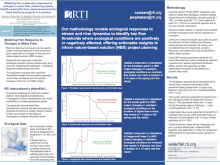Modeling fish community responses to changes in water flow: metrics of improved aquatic habitat as a co-benefit of nature-based solution flood resiliency projects in Louisiana
Chris
Coxen
RTI International
Jennifer Phelan, RTI International
Michele Eddy, RTI International
Sarah Bates, RTI International
Robby Maxwell, Louisiana Department of Wildlife and Fisheries
Raynie Harlan, Louisiana Department of Wildlife and Fisheries
Bryan Piazza, The Nature Conservancy
Katie Kennedy, The Nature Conservancy
Quenton Fontenot, Nicholls State University
Solomon David, University of Minnesota
Serena Gilson, RTI International
Jon Holt, RTI International
Michele Eddy, RTI International
Sarah Bates, RTI International
Robby Maxwell, Louisiana Department of Wildlife and Fisheries
Raynie Harlan, Louisiana Department of Wildlife and Fisheries
Bryan Piazza, The Nature Conservancy
Katie Kennedy, The Nature Conservancy
Quenton Fontenot, Nicholls State University
Solomon David, University of Minnesota
Serena Gilson, RTI International
Jon Holt, RTI International
Poster
A potential co-benefit of nature-based solution (NBS) flood resiliency projects is the beneficial alteration of stream and river flows that improves the quality of habitat for aquatic biota, including fish and benthic species. Machine learning techniques can be used to predict individual species or fish community guild responses to changes in water flow from a NBS project using a space-for-time substitution approach, where flow-ecological condition spatial relationships are modeled as a proxy for modeling flow alteration – ecological response relationship changes over time. We combined multiple state and federal fish sampling datasets from monitoring programs in Louisiana, Mississippi, and Texas to ensure they only included whole fish community sampling events, represented current aquatic conditions (samples from 2011 – 2023), and were standardized to address gear type and sampling method biases. We used NHDPlus catchments as our sampling unit and selected the most recent sampling event available across all catchments in and immediately adjacent to Louisiana. A total of 351 sample units were available for our analyses after filtering. We utilized RTI International’s Louisiana WaterFALL hydrologic model, a rainfall-runoff model that simulates catchment scale daily streamflow, for our explanatory flow metrics. Quantile random forest regression (QRF) was used to model flow-ecological condition spatial relationships for a floodplain spawner guild (N = 198), a sucker guild (N = 71), and Largemouth Bass (N = 145) as an individual species due to its local cultural importance. We examined QRF partial dependence plots for the most influential flow metrics in our best performing models to explore whether there were significant threshold effects (where the response variable significantly increased or decreased at a specific flow value) between the response variable and the flow metric. The floodplain spawner guild was predicted to benefit from overbank flow events (90th percentile flows) greater than 10 days long between February and June (model goodness of fit = 0.45). The sucker guild was predicted to benefit when the average duration of higher-than-normal flows (> 75th percentile flows) are < 3 days during the spring season (February – June) (model goodness of fit = 0.15). Largemouth Bass were predicted to benefit from overbank flow events (75th percentile flows) in February that are greater than 10 days (model goodness of fit = 0.62). These threshold values will be integrated into the Louisiana Watershed Initiative’s NBS Explorer web application to help rank proposed NBS projects by expected aquatic species co-benefit. Where high resolution WaterFALL flow metrics are available, this approach can be used elsewhere to predict the potential ecological effects of altered stream and river dynamics.
Poster PDF

Meeting homepage